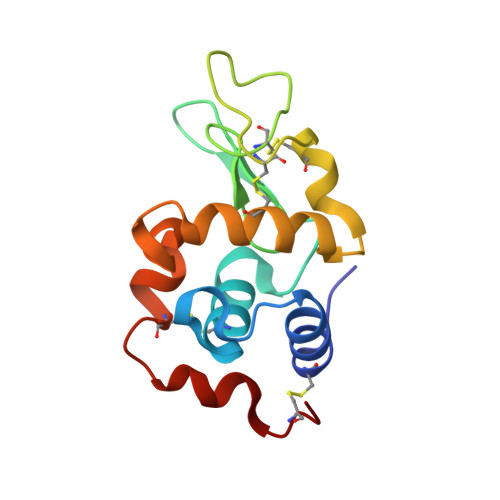Importance of the hydrogen bonding network including Asp52 for catalysis, as revealed by Asn59 mutant hen egg-white lysozymes
Ose, T., Kuroki, K., Matsushima, M., Maenaka, K., Kumagai, I.(2009) J Biochem 146: 651-657
- PubMed: 19605465
- DOI: https://doi.org/10.1093/jb/mvp110
- Primary Citation of Related Structures:
3A3Q, 3A3R - PubMed Abstract:
In the catalysis of sugar hydrolysis by hen egg-white lysozyme, Asp52 is thought to stabilize the reaction intermediate. This residue is involved in the well-ordered hydrogen bonding network including Asn46, Asp48, Ser50 and Asn59 on the anti-parallel beta-sheet, designated as a 'platform', on which the substrate sugar sits. To reveal the role of this hydrogen bonding network in the hydrolysis, we characterized Asn59 mutants by biochemical and crystallographic studies. Surprisingly, the introduction of only a methylene group by the Asn59Gln mutation markedly reduced the bacteriolytic activity and abolished the hydrolytic activity towards the synthetic substrate, PNP-(GlcNAc)(5). A similar result was also obtained with the Asn59Asp mutant. The crystal structure of the Asn59Asp mutant in complex with the substrate analogue revealed that, as in the wild-type, the (GlcNAc)(3) was bound in the A-B-C subsites. The reduced activity would be caused by subtle changes in the side-chain orientations as well as the electrostatic characteristics of Asp59, resulting in the rearrangement of the hydrogen bonding network of the platform. These results suggest that the precise locations of these 'platform' residues, maintained by the well-ordered hydrogen bonding network, are crucial for efficient hydrolysis.
Organizational Affiliation:
Medical Institute of Bioregulation, Kyushu University, Higashi-ku, Fukuoka 812-8582, Japan.
















